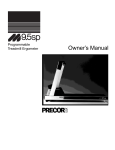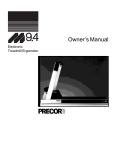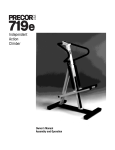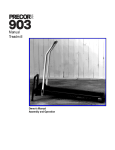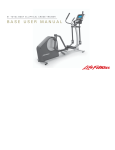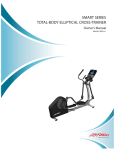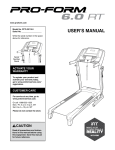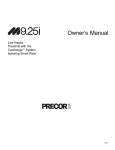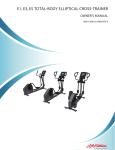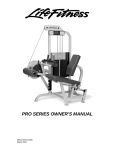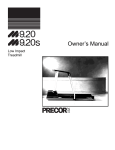Download Owner`s Manual
Transcript
Owner’s Manual R R USA Low-Impact Treadmill page 1 Safety Information Before beginning any fitness program, you should have a complete physical examination by your personal physician. You should also review this manual and become familiar with how to use the M9.3s Low-Impact Treadmill. Read and observe the following guidelines when using this treadmill: • Read the Owner’s Manual and follow all instructions. • Assemble and operate the M9.3s treadmill on a solid, level surface. Locate the treadmill at least 4 feet from walls or furniture. Keep the area behind the treadmill clear. • Never allow children on or near the M9.3s treadmill. Never leave children unsupervised around the treadmill. • Check the M9.3s treadmill before each use. Do not use the treadmill if it is not completely assembled or is damaged in any way. • Keep hands away from moving parts. • Do not use the M9.3s treadmill if you weigh over 250 pounds. The M9.3s treadmill is built to handle persons up to 250 pounds at speeds up to 9 mph. • Wear proper exercise clothing and shoes for your workout—no loose clothing. Do not wear shoes with heels or leather soles. Check the soles of your shoes and remove any embedded stones. Tie long hair back. • Keep all loose clothing and towels away from the treadmill running surface. A treadmill running belt will not stop immediately if an object becomes caught in the belt or rollers. • Use the clip provided to attach the magnetic safety key to your clothing before each workout. By pulling on this key, you can easily stop the running belt if you encounter difficulties or want to end your workout. Note: You need to place the magnetic safety key on the ACTIVATE position of the electronic console before you can turn on the treadmill. page 2 • Use care when getting on or off the M9.3s treadmill. Use the handrails whenever possible. Do not get on or off the treadmill when the running belt is moving. • Before starting the running belt, straddle the belt by placing your feet firmly on the right and left staging platforms. You should also step off the belt and onto the staging platforms after turning off the running belt. • Never turn ON the treadmill when someone is standing on the machine. • Keep your body and head facing forward. Never attempt to turn around on the treadmill when the running belt is moving. • Do not rock the unit. Do not stand or climb on the handrails, electronic console, or hood. • Do not set anything on the handrails, electronic console, or hood. Never place liquids on any part of the treadmill. • Prevent electrical shock by keeping all electrical components, such as the motor, power cord, and ON/OFF switch away from water or other liquids. • Do not use accessory attachments that are not recommended by the manufacturer—such attachments might cause injuries. • Do not attempt to service the M9.3s treadmill yourself. This treadmill does not have any user-serviceable parts. See Getting Service in Section 5 for service information. • Turn OFF the treadmill and wait for the running belt to come to a complete stop before adjusting or working near the rear roller. Do not make any adjustments to the running belt when someone is standing on the machine. • This treadmill is manufactured with six safe “fail-off” systems. If the treadmill encounters a problem, it will trigger a “fail-off” system, allowing the running belt to come to a gradual stop. Continued use of the treadmill after a fail-off system occurs is not recommended. Instead, have your treadmill serviced as described in Getting Service in the maintenance section of this manual. • Do not overexert yourself or work to exhaustion. • Stop your workout immediately if you feel any pain or abnormal symptoms, and consult your physician. Precor treadmills are designed for the enjoyment of the serious runner as well as the dedicated walker. By following the above precautions and using good common sense, you will have many safe and pleasurable hours of healthful exercise with your Precor M9.3s Low-Impact Treadmill. page 3 Table of Contents 1 Quality by Design Before you Begin.................................................................. 5 About this Manual.................................................................. 5 Unpacking the M9.3s.............................................................. 6 2 Setting Up the M9.3s Low-Impact Treadmill Installation Requirements..................................................... 7 Assembly Instructions........................................................... 7 3 Using the M9.3s Low-Impact Treadmill Understanding the Electronic Console.................................. 11 Pre-Programmed Courses..................................................... 12 Interval Training with Interval Mode....................................... 13 Some Tips for Using Interval Mode........................................ 13 Working Out on the M9.3s Treadmill..................................... 14 Using a Pre-Programmed Course......................................... 14 Using Interval Mode............................................................... 17 Selecting the Time or Distance Prompt.................................. 19 Adjusting the Stiffness of the Running Bed.......................... 20 Running on the M9.3s Low-Impact Treadmill......................... 21 Specifying MPH or KPH........................................................ 22 4 Getting the Most Out of Your Workout How Hard Should I Exercise?............................................... 24 How Long Should I Exercise?............................................... 25 How Often Should I Exercise?.............................................. 25 5 Maintenance Cleaning the Treadmill.......................................................... 26 Aligning the Running Belt...................................................... 27 Getting Service...................................................................... 28 page 4 1 Quality by Design Before You Begin Congratulations! You now own one of the newest, most technologically advanced electronic treadmills available. The M9.3s Low-Impact Treadmill belongs to Precor’s exciting “M” series of exercise equipment — a superior combination of high technology and ergonomics. The M9.3s treadmill lets you exercise safely in the convenience of your own home. Turn on the M9.3s treadmill, specify your weight and belt speed, and begin your workout. As you walk or run, the unique running bed protects vulnerable knees and ankles by absorbing much of the impact of each step. Specially designed cylinders absorb the impact while providing a smooth, consistent running surface. For quick, motivating information about your progress, glance at the easy-toread control panel. This console provides information about your elapsed time, speed, distance covered, degree of incline, and total calories burned. If you should encounter a problem during your workout, you can stop the treadmill by pulling on the cord attached to the magnetic safety key. Built with the highest quality materials, the M9.3s Low-Impact Treadmill provides the motivation and challenge you need to help you achieve your fitness goals for years to come. About this Manual This manual explains how to assemble, use, and maintain the M9.3s LowImpact Treadmill. You will also find a basic explanation of aerobic conditioning and information about tailoring a fitness program to your needs. If you encounter problems while installing or using the M9.3s Low-Impact Treadmill, refer to this manual for trouble-shooting information. This manual uses the following conventions: Note: Contains additional information that applies to the preceding text. Important: Indicates information that you should pay special attention to. CAUTION: Indicates steps or information necessary to prevent harm to yourself or damage to the equipment. You do not need any special knowledge or experience to set up an M9.3s LowImpact Treadmill. However, you must carefully review and follow the instruc- page 5 Unpacking the M9.3s Treadmill The M9.3s treadmill is carefully inspected before shipment, so it should arrive in good operating condition. Precor ships the unit in four pieces as listed below: • running bed assembly • control panel assembly • handrails • hardware kit (contents described below) Carefully unpack the parts from the original shipping container. CAUTION: This unit weighs over 150 pounds. To avoid back strain and to ensure the safety of the unit and yourself, we suggest that you drop the sidewalls of the box and slide the running bed assembly from the box, rather than lifting the running bed assembly from the box. After unpacking the treadmill, open the hardware kit and make sure that you have the following items: two 1/4" x 1/2" long socket-head screws four white hole plugs two 2 1/2" x 1 3/8" black labels one 3/16" hex key one 5/32" hex key one 5/16" hex key one magnetic safety key If any items are missing, contact your authorized Precor dealer. For the dealer nearest you, call 1-800-4-PRECOR. Important: The packaging for this equipment was designed to protect it during shipment. Please store the original packaging in a safe place in case you need to ship the M9.3s treadmill in the future. page 6 2 Setting Up the M9.3s Low-Impact Treadmill tions in this manual. If you do not assemble and use this treadmill according to the following guidelines, you could void the Precor warranty. CAUTION: Two persons are recommended to install the lift column, which is part of the assembly procedure. Installation Requirements Follow these installation requirements when installing the treadmill: • Set up the M9.3s treadmill on a solid, flat surface. Do not install the treadmill on deeply padded, plush, or shag carpeting due to possible damage to the carpet and machine. If the treadmill is placed on a carpeted surface, place a piece of heavy cardboard, plywood, or other smooth, flat surface under the unit to protect the carpet and treadmill. • Locate the treadmill at least 4 feet from walls and furniture. Be sure to provide ample space in front of the machine to allow easy access to the ON/OFF switch. Open space to the sides and back of the machine makes for a safer mount and dismount and easier belt adjustment. • Use a standard 120-volt household outlet. Precor recommends that you plug the treadmill into an outlet with a dedicated 20 amp circuit breaker. The treadmill is equipped with a 20 amp circuit breaker to protect the electrical and electronic components from sustained overloads, and an integral 3-prong plug grounded to provide for your safety and to protect the machine. CAUTION: Do not remove or otherwise bypass the 3-prong plug with an adapter in order to use a non-grounded outlet. Assembly Instructions To assemble the M9.3s treadmill, take the following steps : 1. Make sure that the treadmill is unplugged and turned OF. Do not assemble the M9.3s treadmill if it is plugged in or turned ON. 2. After unpacking the M9.3s treadmill, place the front of the running bed assembly on the foam blocks provided in the packaging so that the front edge is about 1-1/2" off the floor. Cut and discard the cable ties holding the front axle. 3. Lift the control panel assembly and position it at the front of the running bed. 4. Align the tab on the side of the ribbon cable connector with its corresponding receptacle. (See Photo 1 on the next page.) Connect the ribbon cable by making sure that all the pins are aligned and fully engaged. page 7 Photo 1 Connect ribbon cable. Running Bed Assembly Ribbon Cable Control Panel Assembly Foam blocks 5. To place the control panel assembly onto the front of the running bed, take the following steps. Refer to Photo 2 for clarification. a. Locate the four mounting bolts on the running bed assembly. Use the hex key provided to unscrew the mounting bolts until four or five threads are visible. b. Position the control panel assembly in front of the running bed assembly. Line up the four mounting bolts on the running bed with the four keyholes in the control panel assembly. Place the control panel assembly onto the mounting bolts, making sure to feed the excess ribbon cable into the frame rail to avoid pinching the ribbon. (See Photo 2.) Photo 2 Place control panel assembly onto mounting bolts. Frame rail Mounting Bolts Keyholes 6. Slide the control panel assembly upward to lock the mounting bolts in place. Tighten the top two bolts using the 5/16" hex key from the hardware kit. (See Photo 3.) page 8 Photo 3 Secure top two bolts. 5/16" hex key 7. Remove the foam blocks and set the base of the treadmill flat on the floor. 8. Loosen the top two bolts one full turn. This will allow the control panel assembly to shift and rest securely on the running bed assembly. You may need to rock the control panel assembly gently so it will seat properly on the four bolts. The lower edges of the control panel assembly should be flush with the base of the treadmill. 9. Firmly tighten all four bolts with the 5/16" hex key and insert the white hole plugs into the mounting bolt access holes. 10. To mount the upper handrails, use a flathead screwdriver to remove the 1" bolt from the RIGHT side of the upper control panel assembly. Note: LEFT and RIGHT are determined while standing behind the treadmill, facing toward the front of the machine. 11. Place the upper end of the RIGHT handrail into the hole in the right column of the control panel assembly. Insert the handrail over the steel bar with the threaded hole. (See Photo 4). 12. Replace the 1" bolt by feeding it through the hole in the handrail and into the threaded hole in the steel bar. To align the holes, you may have to rotate the center bar located under the control panel. Using the flathead screwdriver, tighten the bolt until it feels snug, but do not overtighten. page 9 Photo 4 Insert handlebars into the control panel assembly. 13. Slide the lower end of the RIGHT handrail onto the black fitting located on the side of the frame. (See Photo 5). Align the hole in the handrail with the threaded hole in the fitting. If the holes do not align, slide the 5/32" hex key into the threaded hole and turn the fitting so the holes align. Take a 1/4" x 1/2" socket head screw from the hardware kit and hand thread it into the fitting. Tighten the screw with the 5/32" hex key. 14. To attach the opposite handrail, repeat steps 10 through 13. Photo 5 Attach handlebars to running bed assembly. 15. Attach the labels provided in the hardware kit over each upper handlebar bolt. 16. If you need to move the treadmill, ask for assistance from another person. Roll the treadmill on its front wheels to the new location by lifting the rear end of the unit. CAUTION: Do not attempt to bypass the three-prong plug with an adapter for a non-grounded outlet. page 10 17. Plug the power cord into a grounded 120v household outlet with a dedicated 20 amp circuit breaker. 3 Using the M9.3s Low-Impact Treadmill As simple as using the M9.3s Low-Impact Treadmill may seem, you should read this section so that you can use it safely and effectively. This section provides information about the electronic console displays and instructions on how to use the treadmill during a workout. For information about the electronic console, see Understanding the Electronic Console; for information about working out with the M9.3s treadmill, see Working Out on the M9.3s Treadmill. The M9.3s can indicate speed in miles per hour (mph) or kilometers per hour (kph). When it leaves the factory, the M9.3s is configured to display speed in mph. To change this setting, follow the instructions found in Specifying MPH or KPH in this section. Understanding the Electronic Console The electronic console on the M9.3s lets you control your workout session while providing constant feedback about your progress. Use the SPEED and INCLINE keys to govern speed and degree of incline. An electronic LED display flashes information about elapsed time, speed, distance covered, degree of incline, and total calories burned. Photo 6 shows the M9.3s console. An explanation of each of the keys on the keypad follows the photograph. Photo 6 The M9.3s electronic console INCLINE With the M9.3s treadmill, you can specify an incline from 0 to 10 percent. Simply press the INCLINE key to increase the incline and the INCLINE key to decrease the incline until you reach the desired percentage. Note: The number shown on the display will change faster than the elevation motor can respond. After you select an incline, there may be a brief delay before the specified elevation is reached. If you need to stop the elevation motor, simply press the STOP key. This will also stop the running belt. The display will indicate the incline actually reached. STOP Anytime during a workout or when you finish your workout, or at , press the STOP key to slow the running belt to a safe stop. (You can also stop the treadmill by moving the magnetic safety key from the ACTIVATE to the OFF position.) ACTIVATE To protect you during your workout, you must attach the magnetic safety key to your clothing during each workout. Before turning ON the treadmill, place the key in the ACTIVATE position on the console. Then, if you encounter a problem during your workout, simply pull on the safety key’s cord to stop the running belt. (If you stop the treadmill using the safety key, replace the key on ACTIVATE and turn the treadmill back on to continue your workout.) page 11 OFF After completing your workout by pressing STOP, place the magnetic safety key on the OFF position. You can also stop the treadmill by moving the magnetic safety key from the ACTIVATE to the OFF position. Remove and store the safety key to ensure children or an unqualified person will not be able to activate the treadmill. SCAN ENTER Use the SCAN key to move through the display functions: TIME, SPEED DISTANCE covered, degree of INCLINE, and total CALORIES burned. When the display is set to SCAN, it provides feedback about all the functions in a sequential order. To change from SCAN mode to a constant display of a specific function, press the SCAN key once. The cursor moves to the DISTANCE mode. Continue to press the SCAN key until the cursor indicates the desired function. SPEED The SPEED keys let you control the speed of the running belt. Use to to decrease speed. Pressing starts the running belt increase speed and at .5 mph; if you continue to press this key, speed increases in .2 mph (.3 kph) increments up to 9.0 mph (14.4 kph). Pressing decreases the belt speed at the rate of .6 mph (1 kph) every second. Anytime during your workout, you can see how many minutes it takes you to walk or jog a mile (or kilometer). To use this feature, simultaneously press both SPEED keys and the information appears on the screen. When you release both keys, the speed display returns to the per hour measurement you originally chose (mph or kph). Pre-Programmed Courses The M9.3s treadmill offers a series of ten pre-programmed courses. These courses are designed for anyone interested in working out, whether you are walking, running, starting a fitness program or are already in shape. For each course, you choose the speed and distance; the incline is predetermined according to the level of the course. Choose from WALK 1 to WALK 5 or from RUN 1 to RUN 5. Each course takes the user through a set series of incline intervals, with inclines varying according to the level of the course. The higher the number, the more vigorous the course. For example, WALK 1 takes the user through inclines ranging from 0 to 3 percent grade; RUN 5 has inclines ranging from 0 to 10 percent. You can also specify how you want your workout measured: in distance or time. For example, if you want to run 6 miles, choose the distance option and specify 6 at the prompt (you can choose from .5 to 99.5 miles, in .5 mile increments); if you want to run 20 minutes, select the time option and specify 20 at the prompt (you can choose from 5 to 99 minutes). Please note that distance is the default option. If you want to measure your workout by time, you must specify that option following the procedure in Selecting the Time or Distance Prompt in this section. To help you monitor your workout, press the SCAN/ENTER key. The treadmill displays a readout on distance, time, speed, calories, and incline. This display also appears at each transition point. page 12 Interval Training with Interval Mode Besides choosing a pre-programmed course, you can choose the Interval Mode option. Use this option to design your own interval training program. Interval training provides numerous benefits. Since interval training segments the workout into smaller components, a 20- or 30-minute workout seems to pass more quickly. In addition, studies have shown that it is a more efficient method for achieving aerobic benefits—you start seeing improved cardiovascular fitness much sooner with less effort. Recent studies also show that people who interval train are more likely to stick with their fitness program. Interval training consists of brief periods of elevated activity followed by brief periods of reduced activity. The Interval Mode option alternates between 60 seconds of “Rest” and 60 seconds of “Work.” During the Rest interval, you can walk or jog slowly; during the Work interval, you can stride quickly or run. You specify the Rest and Work speeds at the beginning of the first interval. The microprocessor remembers the speed and returns to that speed at the beginning of each subsequent Rest or Work interval. With the M9.3s treadmill, you can also specify the incline for the Rest and Work intervals, allowing you to increase and decrease your workload using both speed and incline. The microprocessor remembers the incline you set for each interval and returns to that incline at the beginning of the next interval. At any point during the workout, you can change the speed and incline of the current interval. For example, if you realize that 8 miles per hour is a little faster than you prefer during a Work interval, simply use the SPEED key to reduce the speed. The microprocessor remembers the new speed for the next Work interval. To help you monitor your workout, the treadmill automatically displays a readout on distance, time, speed, calories, and incline. This display occurs every thirty seconds and at each transition point. To randomly display this readout anytime during your workout, press the SCAN/ENTER key. Some Tips for Using Interval Mode Here are some suggestions that may help you incorporate the Interval Mode into your workout: • If you are starting an exercise program, the Interval Mode option can help you increase your workload gradually. For example, in the beginning, you may simply want to specify the same speed for both Work and Rest intervals. Then, to increase your effort level, change to a higher speed for your Work interval. • If you are training with the goal of maintaining a constant pace when on level ground or grade, specify the same speed for both Work and Rest intervals. Then, gradually increase the incline during the Work interval until you can maintain a constant pace. page 13 Working Out on the M9.3s Treadmill Before using one of the pre-programmed courses, Interval Mode (INTV), or the Manual (MAN’L) options on your treadmill, we recommend that you follow the instructions given here and go through a preliminary demonstration of the features. Then, you will be familiar with the treadmill when you begin your workout. When using the treadmill, follow these general guidelines: • At the beginning of a workout, take several minutes to bring your heart rate into your training zone, which is shown in Diagram 3 later in this manual. • After your workout, walk slowly for several minutes to cool down your body and lower your pulse rate. • Using the clip provided, attach the magnetic safety key to your clothing before each workout. Then, if you encounter difficulties or want to end your workout, you can easily stop the running belt by pulling on the cord. • Gently stretch your lower body and back after a workout to help prevent stiffness or soreness. Pausing Your Workout. You can pause your workout at any time by pressing STOP briefly. To continue your workout, use the SPEED arrow keys to reset your speed. When using Interval Mode, you must re-enter the speed of the mode you were in when you paused your workout. For example, if you paused your workout during the Rest interval, you must reset the speed for that interval. In this example, you would not need to reset the speed for the Work interval, since the microprocessor will remember the previously specified speed. Ending Your Workout. To end your workout, press STOP. This will slow the treadmill to a gradual stop. The display will begin to scan and allow you to review the total time, distance and caloric burn of your workout. If you press STOP twice in quick succession, your treadmill will go to manual mode allowing you to do some “cool down” exercise. To reset your treadmill, press the STOP key and hold it for several seconds. This clears all data. Using a Pre-Programmed Course To use a pre-programmed course, follow the instructions below. Remember, when you use the electronic console, hold onto the handrail to maintain your balance. You should also use the handrail whenever you speed up, slow down, or stop the treadmill. CAUTION: If this is the first time you have operated this treadmill, DO NOT STAND on the running belt until you become familiar with M9.3s operations. 1. On the electronic console, place the magnetic safety key on the ACTIVATE position. Walk to the front of the treadmill and turn ON the treadmill using the ON/OFF switch. The treadmill will not turn on unless the safety key is in the ACTIVATE position. 2. Straddle the running belt with your feet firmly planted on the right and left staging platforms. Stand close enough to the electronic console so you can extend your arms and touch the keypad. page 14 3. Using the clip provided, securely attach the magnetic safety key to your exercise clothing at your waistline, where it will not interfere with your workout. 4. When you see “Enter Weight” scroll across the display, specify your weight using the SPEED arrow keys. The number on the display moves in 5-pound increments up or down, depending on the arrow key pressed. Use to increase and to decrease the weight displayed. When the correct weight is displayed, press SCAN/ENTER. This information allows the M9.3s to calculate how many calories you burn during your workout. The treadmill automatically remembers the last weight entered. During your next workout, you restore your weight from the treadmill’s memory by simply pressing SCAN/ENTER at the “Enter Weight” prompt. However, if someone else has used the treadmill prior to your workout, you need to reenter your weight. Note: The prompt “Press Enter to Begin” appears after 10 seconds if you have not pressed SCAN/ENTER. This prompt continues to scroll across the display every 10 seconds until you press SCAN/ENTER. 5. At the “Select Course” prompt, choose your workout mode: either Manual (MAN’L), Interval (INTV), or one of the ten pre-programmed courses. Press the arrow keys until you see the desired mode or course, then press SCAN/ ENTER. Since these instructions explain how to use a pre-programmed course, select a course: WALK 1 through RUN 5. To help you decide on which course you want to use, Diagram 1 on the following page, gives an overview of each course. Each course combines .5-mile segments with a set series of inclines. The percent of incline and the frequency with which inclines are encountered indicate the difficulty of the course. For example, WALK 1 has inclines ranging from 0 to 3 percent; RUN 5 has inclines ranging from 0 to 10 percent. The microprocessor simply repeats the .5-mile segments until the workout ends. Manual Mode is the default selection for the “Select Course” prompt. After specifying your mode, you will not need to specify the mode again. The microprocessor automatically remembers the last mode selected. At your next workout, simply press SCAN/ENTER at the “Select Course” prompt. (If another person uses the machine, you might need to specify the mode again as described in this step.) Note: If you do not press SCAN/ENTER to select a course, after 10 seconds the prompt “Press Enter” appears. This prompt continues to scroll across the display every 10 seconds until SCAN/ENTER is pressed. page 15 Diagram 1 Overview of Pre-Programmed Courses Walk 1 0 1 Walk 2 0 1 3 2 1 1 0 1 0 1 0 0 1 0 0 1 3 2 1 4 3 2 2 1 2 1 0 1 0 1 3 2 3 1 3 Walk 3 0 3 Walk 4 3 0 0 0 4 3 3 0 5 3 0 4 8 5 Walk 5 Run 1 0 8 6 5 2 3 Run 2 3 0 1 1 0 0 1 0 0 0 1 2 Run 3 2 4 0 3 0 0 7 7 6 3 0 2 0 7 0 8 7 5 0 0 3 2 3 Run 5 2 6 4 0 0 1 0 6 Run 4 1 4 2 6 3 0 7 6 3 0 4 3 0 6 5 0 7 3 0 0 7 4 6 4 3 0 6 3 4 0 7 6 3 4 7 4 3 0 0 0 7 4 2 5 8 6 0 0 6. At the “Select miles (kilometers)” prompt, specify the length of your course. Press the arrow keys to choose distance; the display moves in .5 increments, from .5 to 99.5 miles (kilometers). Press SCAN/ENTER when the desired distance is shown. If you see “Select Time” scroll across the display, specify the length of your workout. Press the arrow keys to choose time; the display moves in 1 minute increments, from 5 to 99 minutes. Press SCAN/ENTER when the desired time is shown. Note: You can change the “Select Distance” prompt to “Select Time” if you prefer to measure your workout by time. Follow the procedure in Selecting the Time or Distance Prompt at the end of this section. 7. Stand on the running belt with one hand on the handrail, prepare to start walking. With your other hand, press the SPEED arrow keys until you reach your desired speed. Now, simply continue working out. Your workout will continue until the specified distance or time is reached, or until the STOP key is pressed. Anytime during your workout, you can change your speed. page 16 8. When you are finished working out, hold onto the handrail and press STOP. The treadmill will come to a safe stop. Be sure to remove the magnetic safety key from your clothing, and return it to the OFF position or remove entirely and store in a safe place to guard against use by children or persons unfamiliar with the treadmill. Note: If desired, you can cool down before ending your workout by pressing STOP twice in quick succession. The treadmill will stop and enter the Manual Mode, allowing you to specify the speed and incline of your cool down period. Using Interval Mode To use the Interval Mode option, follow the instructions below. Remember, when you use the electronic console, hold onto the handrail to maintain your balance. You should also use the handrail whenever you speed up, slow down, or stop the treadmill. CAUTION: If this is the first time you have operated this treadmill, DO NOT STAND on the running belt until you become familiar with M9.3s operations. 1. Place the magnetic safety key on the ACTIVATE position of the electronic console. Walk to the rear of the treadmill and turn the switch to ON. (The treadmill will not operate unless the safety key is in the ACTIVATE position.) 2. Straddle the running belt with your feet firmly planted on the right and left staging platforms. Stand close enough to the electronic console so you can extend your arms and touch the keypad. 3. Using the clip provided, securely attach the magnetic safety key to your exercise clothing at your waistline, where it will not interfere with your workout. 4. When you see “Enter Weight” scroll across the display, specify your weight using the SPEED arrow keys. The number on the display moves in 5-pound increments up or down, depending on the arrow key pressed. Use to increase and to decrease the weight displayed. When the correct weight is displayed, press SCAN/ENTER. This information allows the M9.3s to calculate how many calories you burn during your workout. The treadmill automatically remembers the last weight entered. During your next workout, you restore your weight from the treadmill’s memory by pressing SCAN/ENTER at the “Enter Weight” prompt. However, if someone else has used the treadmill prior to your workout, you need to re-enter your weight. Note: The prompt “Press Enter to Begin” appears after 10 seconds if you have not pressed SCAN/ENTER. This prompt continues to scroll across the display every 10 seconds until you press SCAN/ENTER. 5. At the “Select Course” prompt, choose your workout mode, either Interval (INTV), Manual (MAN’L), or one of the ten pre-programmed courses (WALK 1 through RUN 5). Press the arrow keys until you see the desired mode or course, then press SCAN/ENTER. Since these instructions explain how to use the Interval Mode, select INTV. page 17 Manual Mode is the default selection at the “Select Course” prompt. After specifying your mode, you will not need to specify the mode again. The microprocessor automatically remembers the last mode selected. At your next workout, simply press SCAN/ENTER at the “Select Course” prompt. (If another person uses the machine, you might need to specify the mode again as described in this step.) Note: If you do not press SCAN/ENTER to select a course, after 10 seconds the prompt “Press Enter” appears. This prompt continues to scroll across the display every 10 seconds until SCAN/ENTER is pressed. 6. At the “Enter Rest Speed and Incline” prompt, stand on the running belt with one hand on the handrail, prepared to start walking. With your other hand, press the SPEED arrow key and Incline arrows until you reach a comfortable rest speed and incline, either running or walking. When the desired speed is displayed release the arrow and simply continue working out—you do not need to press SCAN/ENTER. Once you set your Rest speed and incline, the microprocessor remembers that speed and returns to it at the beginning of each Rest interval, until you change the speed or end your workout. 7. When you see “Enter Work Speed and Incline” scroll across the display, specify your Work speed and Incline. With one hand on the handrail, use the other hand to press the SPEED arrow keys and Incline arrows until the desired Work speed and Incline is shown. Then let go of the handrail and continue working out—you do not need to press SCAN/ENTER. You can specify a speed up to 9 miles an hour. The microprocessor remembers the specified Work speed and returns to it at the beginning of each Work interval, until you change the speed or stop your workout. Each Rest and Work interval lasts 60 seconds. The display automatically counts down to the next interval. When the count reaches 30 seconds, the display changes and gives information about distance traveled, time elapsed, speed, calories burned, and percent of incline. You can also get this information at any time by pressing SCAN/ENTER. When the treadmill changes intervals, it informs you with “Going to Rest Speed and Incline” or “Going to Work Speed and Incline” messages on the display. Anytime during an interval, you can change the incline using the INCLINE arrow keys. Once you specify an incline for an interval, the microprocessor in the M9.3s treadmill remembers that incline and returns to it each time the interval is repeated. 8. When you are finished working out, hold onto the handrail and press STOP. The treadmill will come to a safe stop. Be sure to remove it the magnetic safety key from your clothing, and return it to the OFF position or remove entirely and store in a safe place to guard against use by children or persons unfamiliar with the treadmill. Note: If desired, you can cool down before ending your workout by pressing STOP twice in quick succession. The treadmill stops and enters Manual Mode, allowing you to specify the speed and incline of your cool down period. page 18 Selecting the Time or Distance Prompt When using a pre-programmed course, you can measure your workout by distance or time. You see the “Select Distance” or “Select Time” prompt after you specify a course (see Step 6 of the procedure, Using a Pre-Programmed Course). The default measurement is distance. To change the prompt, follow these instructions: 1. Place the magnetic safety key on the ACTIVATE position of the electronic console. Walk to the rear of the treadmill and turn the power switch to ON. (The treadmill will not operate unless the safety key is in the ACTIVATE position.) 2. Straddle the running belt with your feet firmly planted on the right and left staging platforms. Stand close enough to the electronic console so you can extend your arms and touch the keypad. 3. Using the clip provided, securely attach the magnetic safety key to your exercise clothing at your waistline, where it will not interfere with your workout. 4. When you see “Enter Weight” scroll across the display, press the SPEED key and SCAN/ENTER key simultaneously. 5. When you see “Press for MPH or for KPH,” press the SPEED key. (If you are using kilometers, press the SPEED key.) After you press the SPEED key, the message, “MPH and Miles Mode” scrolls across the display. 6. When you see “Push for Distance for Time or ‘STOP’ for Ask,” press the appropriate key after answering one of the following “if/then” scenarios: If you want... Then... your workout measured by distance • press the key your workout measured by time • press the key the option of selecting time or distance prior to each workout • press STOP After you press an arrow key, the display shows “Distance Mode” or “Time Mode,” depending on the key pressed. The message, “Enter Weight” scrolls across the display. 7. Either continue with your workout or turn off the treadmill by pulling the safety key off the ACTIVATE position. If you turn off the treadmill, be sure to remove the magnetic safety key from your clothing, and return it to the OFF position or remove entirely and store in a safe place to guard against use by children or persons unfamiliar with the treadmill. page 19 Adjusting the Stiffness of the Running Bed The M9.3s Low-Impact Treadmill is specially designed to allow you to adjust the amount of impact reduction. Three levels are available: Level 1, Hard; Level 2, Medium; and Level 3, Soft. The level you choose depends on your weight and running style. To choose the best impact reduction level for you, use the treadmill with the running bed set at each of the settings. Then, select the level that suits your exercise style the best. Important: Do not adjust the bed impact reduction level when someone is standing, walking or running on the treadmill. Be sure to turn OFF the treadmill, before making any adjustments. To adjust the running bed impact reduction level, follow these steps: 1. Facing the side of the treadmill, firmly grasp the control lever shown in Photo 7 and pull the lever outward until the upper end is clear of the hole. 2. Rotate the lever right or left, and insert the end of the lever into the hole at the desired setting. Photo 7 page 20 Control lever for adjusting impact reduction. Running on the M9.3s Low-Impact Treadmill Before using the M9.3s Low-Impact Treadmill for an actual workout, we recommend that you follow these instructions and go through a preliminary demonstration of the unit. This will make you more familiar with the unit when you begin your first workout. When using the treadmill, follow these general guidelines: • At the beginning of a workout, take several minutes to bring your heart rate into your training zone, which is shown in Diagram 3 later in this manual. After your workout, walk slowly for several minutes to cool down your body and lower your pulse rate. • Attach the magnetic safety key to your clothing before each workout. (Use the clip provided on the end of the cord to attach the key.) Then, if you encounter difficulties or want to end your workout, you can easily stop the running belt by pulling on the cord. • Gently stretch your lower body and back after a workout to help prevent stiffness or soreness. To use the treadmill, follow the instructions below. Remember, when you use the electronic console, hold onto the handrail to maintain your balance. You should also use the handrail whenever you slow down or stop the treadmill. Important: Before working out on the treadmill, make sure the running belt is correctly aligned. Correct alignment is critical to the smooth and safe operation of the treadmill. For more information, see Aligning the Running Belt. 1. Place the magnetic safety key on the ACTIVATE position of the electronic console. Walk to the rear of the treadmill and turn the switch to ON. (The treadmill will not operate unless the safety key is in the ACTIVATE position.) 2. Straddle the running belt with your feet firmly planted on the right and left staging platforms. Stand close enough to the electronic console so you can extend your arms and touch the keypad. 3. Using the clip provided, securely attach the magnetic safety key to your exercise clothing at your waistline, where it will not interfere with your workout. 4. When you see “Enter Weight 125lb” scroll across the display, specify your weight using the SPEED arrow keys. The number on the display moves in 5-pound increments up or down, depending on the arrow key pressed. Use to increase and to decrease the weight displayed. When the correct weight appears, press SCAN/ENTER. This information allows the M9.3s to calculate how many calories you burn during your workout. The treadmill automatically remembers the last weight entered. During your next workout, you restore your weight from the treadmill’s memory by pressing SCAN/ENTER at the “Enter Weight” prompt. However, if someone else has used the treadmill prior to your workout, you need to re-enter your weight. page 21 5. Stand on the running belt while keeping one hand on the handrail. With your other hand, press the SPEED key until you reach a comfortable walking speed — about 1.5 to 2.0 mph. 6. Walk for a few minutes with both hands on the handrail to get comfortable with the treadmill. Next, hold the handrail with one hand, and use the other hand to increase the speed to about 3.0 mph. Walk at this speed for a few minutes to warm up your muscles. 7. Let go of the handrail with one hand, and let your arm swing naturally. 8. Let go with your other hand. Walk with both arms swinging naturally. Keep this pace for a few minutes. 9. When you feel comfortable walking, you may wish to jog. Hold the handrail with one hand and use the other to increase speed to 5.0 mph. 10. Begin jogging with both hands on the handrails. As you become more comfortable, remove one hand, then the other. 10. When you are finished working out, hold onto the handrail and press the red STOP key to come to a safe stop. Moving the magnetic safety key from the ACTIVATE to the OFF position, also stops the treadmill. Always cool down for a few minutes before bringing the treadmill to a complete stop. Remove and store the safety key to insure children or an unqualified person will not be able to activate the treadmill. Specifying MPH or KPH The M9.3s Low-Impact Treadmill can display speed in miles per hour (mph) or kilometers per hour (kph). When the M9.3s is shipped from the factory, it displays speed in mph. You can easily change this setting by following the steps below. The M9.3s treadmill will retain your selection even when it is turned off or unplugged. You can change your selection at any time by repeating these steps. CAUTION: Do not stand on the belt during this procedure. 1. Place the magnetic safety key on the ACTIVATE position of the electronic console. Walk to the rear of the treadmill and turn the power switch to ON. (The magnetic safety key must be placed in the ACTIVATE position before you can turn on the treadmill.) 2. Straddle the running belt with your feet firmly planted on the right and left staging platforms. (Stand close enough so you can extend your arm and touch the keypad.) Use the clip on the magnetic safety key to attach it to your clothing at your waistline. 3. When the prompt “Enter Weight” appears, press and hold the green SPEED key and the SCAN/ENTER key. Release both keys. 4. Select mph by pressing SPEED , or select kph by pressing SPEED . You can continue your workout by following the appropriate steps found in Running on the M9.3s Treadmill or stop the treadmill by pulling on the magnetic safety key and turning the treadmill OFF. page 22 4 Getting the Most Out of Your Workout A workout on the M9.3s Low-Impact Treadmill provides excellent and efficient cardiovascular conditioning, while strengthening and toning all the major muscle groups in the lower body. Darkened areas in Diagram 2 indicate the muscles that can be improved. To get the most out of each workout, a general understanding of the principles behind aerobic training is invaluable. The best source of fitness information is your specialty fitness dealer. In addition to providing information on which exercise equipment is the best for your individual needs, your specialty fitness retailer can provide useful advice on training, technique, and exercise physiology. Your retailer can also recommend good books on these subjects. Diagram 2 1. 2. 3. 4. 5. 6. 7. 8. 9. 10. 11. 12. 13. 14. 15. 16. Muscles in the body. Trapezius Deltoid Pectorals Rhomboids Triceps Biceps Latissimus Dorsi Forearm Flexors/Extensors Abdominals Erector Spinae Gluteals Hip Flexors Quadriceps Hamstrings Gastrocnemius/Soleus Peroneus Longus/Brevis 1 2 3 1 2 4 6 9 5 8 7 10 8 12 11 13 14 16 15 16 To help you get started in planning and carrying out your fitness program, this section provides some basic information on aerobic exercise—such as how hard you should work out, how long each session should be, and how often you need to exercise to benefit from a regular program. page 23 How Hard Should I Exercise? Studies show that to achieve the benefits of aerobic exercise, it is necessary to work out hard enough raise your heart rate to a certain minimum level, called a “training zone.” Your training zone depends on your age and level of fitness. Refer to Diagram 3 to determine your training zone. Keep in mind that this zone is an approximation, to be used as a guideline—individual heart rates vary according to several physiological factors. To determine your training zone, or target heart rate, find your age and fitness level on the chart, and then find the line where they intersect. For example, if you are 35 years old, your training heart rate at the intermediate fitness level is 157 beats per minute. Remember this number—this is the pulse rate you should try to maintain as you work out. Diagram 3 Your Heart Rate HEART RATE TRAINING ZONES 200 195 200 190 185 190 180 YOUR HEART RATE 175 171 170 166 166 anc 162 162 160 157 170 Adv 160 157 Inte 149 150 155 153 rme 153 diat e Beg 136 133 145 144 139 140 inn 130 150 148 145 140 140 165 ed 123 120 131 132 126 130 100% 135 136 er 128 123 119 90% 85% 115 112 110 MAXIMUM ATTTAINABLE HEART RATE 170 180 175 180 108 105 102 100 70% 90 80 20 25 30 35 40 45 50 55 60 65 70 75 YOUR AGE To determine your heart rate, take your pulse at a place that you can reach easily and comfortably while you exercise. Typical locations for measuring heart rate are directly over the heart on the left side of the chest, on either side of the neck, over the temple, or on the thumb side of either wrist. Wherever you measure your pulse, make sure that you use your index and middle fingers— not your thumb. Your thumb has a strong pulse which can affect your heart rate reading. Once you locate your pulse, look at a clock with a second hand and count the beats for six seconds. Multiply that number by 10 to determine the total number of beats per minute. For example, if you count 14 beats over six seconds, the total number of beats per minute is 140. Compare the total number of beats with your training zone as identified in Diagram 3. If necessary, increase or decrease your activity level to bring your heart rate into your training zone. You can increase your activity level by decreasing the resistance and stepping at a higher cadence. Similarly, raising the resistance and decreasing your steps per minute will lower your heart rate. Remember—your heart rate is the definitive measure of how hard you are working. page 24 Regardless of your fitness level, avoid doing too much too soon. Setting the resistance cylinders too far forward, stepping too deeply (taking large steps) or stepping too quickly for too long are common errors. Give yourself time to become familiar with your climber and improve your fitness level. Then you can gradually decrease your resistance level and increase your stepping cadence to make your workouts more challenging. How Long Should I Exercise? The length of each exercise session depends on your fitness level. Exercise physiologists have determined that, to attain cardiovascular benefits from exercise, you should maintain your heart rate in the training zone for at least 15 minutes. This is in addition to your warm-up time, and does not include cooldown. You should always allow several minutes to bring your heart rate into the training zone, by starting out slowly and gradually increasing the work level. Similarly, use several minutes of light exercise after the workout to bring your heart rate down to near resting level. The higher your fitness level, the longer your should maintain your heart rate in the training zone (between 20 and 30 minutes). Beginners should always start slowly, and gradually get their sessions up to 20 minutes or more. Walking and running are excellent aerobic exercises that condition the heart and lungs while improving strength and tone in the thighs, calves, and hips. The best aerobic exercises involve the continuous, rhythmic, repetitive movement of large muscle groups. When you exercise, you need to work out hard enough, long enough, and often enough to achieve your desired results. How Often Should I Exercise? Research indicates that aerobic sessions of 20 minutes or more should be done at least three to five times a week to obtain significant cardiovascular benefits. Most experts agree that sensible eating habits and regular aerobic exercise are the keys to weight control and fitness. A recent study, which tracked several subjects over a period of years, conclusively shows that exercise, not dieting, is the key factor to successful long-term weight loss. To help you get the most out of your workout, this section provides suggestions about aerobic exercise. Following these suggestions will help you reach your fitness goals. page 25 5 Maintaining the M9.3s Treadmill The M9.3s treadmill requires little maintenance to keep it running smoothly and efficiently. Typical maintenance tasks include cleaning the treadmill and adjusting the running belt. Instructions for both procedures are provided in this section. Cleaning the M9.3s Low Impact Treadmill Your Precor precision treadmill relies on low friction for efficient operation. To keep the friction low, the treadmill must be as clean as possible. Photo 8 illustrates the locations that should be kept clean. CAUTION: Turn OFF the treadmill and unplug the power cord before cleaning. Before a workout, use a damp, soft cloth to clean the staging platforms, running bed, and under the belt as far as you can easily reach. This removes any dirt or dust that might affect the smooth operation of the treadmill. Photo 8 Keep these areas on the M9.3s treadmill clean. Frame Running belt Margins of running bed Vacuum underneath the unit every week to prevent the accumulation of dust and dirt on the running belt. Periodically, clean the treadmill’s frame, electronic console, and running belt using mild soap and water. To clean the running belt, use a soft nylon scrub brush. Do not pour water or spray liquids on the control panel. Allow the treadmill to dry completely before using. page 26 Aligning the Running Belt The M9.3s Low-Impact Treadmill is designed so that the running belt automatically centers itself on the running bed when the treadmill is in use. Proper belt alignment is important because it allows the belt to remain centered, and it assures the smooth operation of the treadmill. The belt is aligned at the factory before shipment. However, during shipment, or by using the treadmill on an uneven surface, the belt may move off center. Realigning the belt takes a few simple adjustments. If you are unsure about this procedure, call your authorized Precor dealer for service. Important: If you notice the belt needs alignment, make the adjustments at once. Failure to do so may cause the belt to tear or fray; this damage is not covered by warranty. CAUTION: Special care must be taken when aligning the running belt. Remove any loose clothing and tie back your hair before adjusting the belt. Be very careful to keep your fingers or any other object clear of the belt and rollers, especially in front of the deck and behind the roller. The treadmill will not stop immediately if any object becomes caught in the belt or rollers. The M9.3s Low-Impact Treadmill is designed to carry people who weigh up to 250 pounds at speeds from .5 to 9 miles per hour. To align the running belt, take the following steps: 1. Place the magnetic safety key on the ACTIVATE position and turn ON the treadmill, using the switch located on the rear of the M9.3s. 2. Press and hold the SPEED increase key until the belt speed reads 6.0 mph on the control panel display. 3. Walk to the front of the treadmill and observe the operation of the belt for about a minute. If the belt is centered on the treadmill as it runs, the belt does not need adjustment. Skip to Step 7. However, if the belt runs off center, you need to adjust it. Continue to Step 4. 4. Turn OFF the treadmill. Wait for the running belt to come to a complete stop. 5. Using the right-hand adjusting screw located at the front of the treadmill (see Photo 9), adjust the belt accordingly: • To move the belt left, turn the screw 1/4 turn clockwise using a hex key. • To move the belt right, turn the adjusting screw 1/4 turn counterclockwise. Do not turn the adjusting screw more than 1/4 turn at a time. Important: Before making each adjustment, make sure the treadmill is OFF and the belt has completely stopped. page 27 Photo 9 Aligning the running belt. Right-hand adjusting screw 6. After adjusting the belt, let the treadmill run for a couple of minutes to check the alignment and to make sure the belt is stable. If more correction is required, repeat steps 4 and 5 by turning the adjusting screw another 1/4 turn, then check the result. If you overcorrect, turn the screw in the opposite direction. (Refer to Photo 9.) 7. Once the belt is properly aligned, press the STOP key to stop the belt. Getting Service Do not attempt to service the M9.3s Low-Impact treadmill yourself except for performing the maintenance tasks as described in this manual. For further information about product operation or service, contact an authorized Precor dealer (or a Precor Factory Authorized Service Company). To locate the Precor dealer nearest you, call 1-800-4-PRECOR. page 28 USA R Precor Incorporated P.O. Box 3004 Bothell, WA USA 98041-3004 Precor and "M" registered trademarks of Precor Incorporated. © 1990 Precor Incorporated, Rd. 1990. Specifications subject to change without notice. 1-800-4-PRECOR P/N 33045-102 6/92 page 29





























